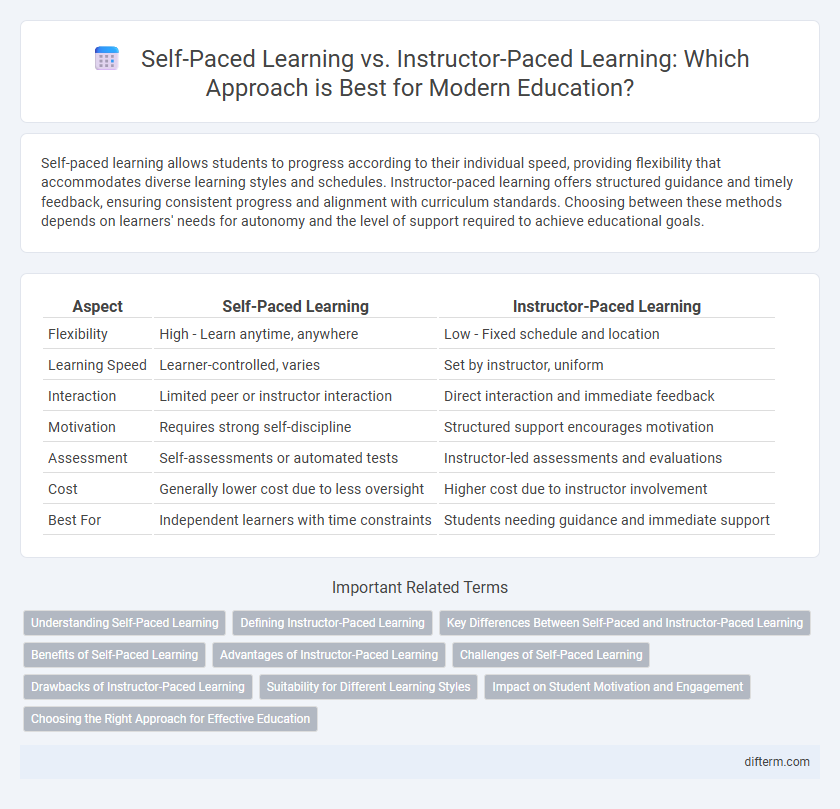Self-paced learning allows students to progress according to their individual speed, providing flexibility that accommodates diverse learning styles and schedules. Instructor-paced learning offers structured guidance and timely feedback, ensuring consistent progress and alignment with curriculum standards. Choosing between these methods depends on learners' needs for autonomy and the level of support required to achieve educational goals.
Table of Comparison
| Aspect | Self-Paced Learning | Instructor-Paced Learning |
|---|---|---|
| Flexibility | High - Learn anytime, anywhere | Low - Fixed schedule and location |
| Learning Speed | Learner-controlled, varies | Set by instructor, uniform |
| Interaction | Limited peer or instructor interaction | Direct interaction and immediate feedback |
| Motivation | Requires strong self-discipline | Structured support encourages motivation |
| Assessment | Self-assessments or automated tests | Instructor-led assessments and evaluations |
| Cost | Generally lower cost due to less oversight | Higher cost due to instructor involvement |
| Best For | Independent learners with time constraints | Students needing guidance and immediate support |
Understanding Self-Paced Learning
Self-paced learning allows students to control the timing and speed of their educational journey, enabling personalized comprehension and flexible study schedules. This method supports diverse learning styles by providing the opportunity to revisit materials until mastery is achieved, promoting deeper understanding. Research indicates that self-paced learning enhances learner autonomy and motivation, often resulting in improved retention and application of knowledge compared to instructor-paced environments.
Defining Instructor-Paced Learning
Instructor-paced learning is a structured educational approach where the instructor controls the timeline and delivery of content, setting fixed schedules for lectures, assignments, and assessments. This method ensures consistent progression among students, enabling real-time interaction and immediate feedback during class sessions. It contrasts with self-paced learning by emphasizing synchronous participation and guided pacing to achieve learning objectives within a specific timeframe.
Key Differences Between Self-Paced and Instructor-Paced Learning
Self-paced learning allows students to control the speed and timing of their studies, enabling personalized schedules and flexibility in mastering material, whereas instructor-paced learning follows a fixed timeline dictated by the teacher's curriculum plan. Self-paced formats often utilize digital platforms and asynchronous content, supporting diverse learning styles and promoting autonomy, while instructor-paced courses emphasize real-time interactions, structured guidance, and synchronous activities. These fundamental differences impact student engagement, motivation, and retention outcomes, with self-paced environments fostering independence and instructor-paced models providing immediate feedback and accountability.
Benefits of Self-Paced Learning
Self-paced learning offers learners the flexibility to control their study schedule, allowing for personalized progress that accommodates individual learning speeds and styles. This approach enhances knowledge retention by enabling repeated practice and review without the pressure of keeping up with a group. Moreover, self-paced learning increases accessibility and convenience, supporting diverse learners who balance education with work, family, or other commitments.
Advantages of Instructor-Paced Learning
Instructor-paced learning offers structured guidance that enhances student motivation and accountability through scheduled lessons and deadlines. Real-time interaction with instructors facilitates immediate feedback, clarifies complex concepts, and fosters a collaborative learning environment. This method supports consistent progress and helps learners develop discipline essential for mastering challenging educational content.
Challenges of Self-Paced Learning
Self-paced learning often presents challenges such as limited real-time feedback and decreased learner motivation, which can hinder knowledge retention and skill development. Learners may struggle with time management and maintaining discipline without structured schedules or instructor guidance. Technology access and digital literacy also play critical roles in the effectiveness of self-paced learning environments.
Drawbacks of Instructor-Paced Learning
Instructor-paced learning often limits student flexibility, causing difficulties for learners with varying schedules or paces. This rigid structure may result in reduced engagement and increased stress for those needing more time to grasp complex concepts. Furthermore, instructor-paced models can hinder personalized learning, failing to address individual strengths and weaknesses effectively.
Suitability for Different Learning Styles
Self-paced learning offers flexible schedules tailored to individual preferences, making it ideal for autonomous learners who thrive on self-motivation and personalized pacing. Instructor-paced learning suits students who benefit from structured guidance, regular feedback, and collaborative environments emphasizing social interaction and discipline. Understanding the alignment between learning styles and pacing models enhances educational outcomes by accommodating diverse cognitive and motivational needs.
Impact on Student Motivation and Engagement
Self-paced learning enhances student motivation by allowing learners to control their study schedule and progress at their own speed, fostering a sense of autonomy and personalized achievement. Instructor-paced learning provides structured timelines and real-time feedback, which can maintain engagement through consistent accountability and social interaction. Research shows a balanced integration of both methods often leads to optimal student motivation and sustained educational engagement.
Choosing the Right Approach for Effective Education
Self-paced learning allows students to progress according to their individual speed, promoting personalized understanding and flexibility in mastering concepts. Instructor-paced learning provides structured guidance and consistent pacing, which helps maintain accountability and ensures timely coverage of curriculum standards. Selecting the right approach depends on the learner's motivation, time management skills, and educational goals to maximize engagement and knowledge retention.
Self-paced learning vs instructor-paced learning Infographic

 difterm.com
difterm.com